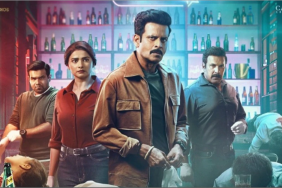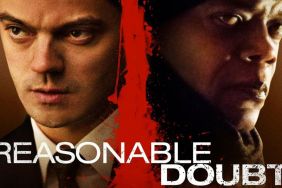
The Christian liturgical service known as Tenebrae is celebrated in the shadows. Candles flicker against the walls of the church while the Psalms are chanted by various readers, each reciting a chapter about the final days in the life of Jesus the Passion, which leads to the crucifixion. They extinguish the candles one by one until the congregation sits silent in total darkness.
Dario Argentos 1982 film Tenebre signifies another kind of blindness the gray areas of morality and the artist’s amoral and compulsive nature. In one of the films stunning murder set pieces, in which the journalist character Tilde (Mirella D’Angelo) is dressing head shrouded by her white shirt the killers black-gloved, razor-wielding hands appear, slicing an ocular window into the fabric. It frames Tildes wide-eyed expression, which just moments before was gazing into Argentos camera as the disembodied voice of the killer hisses, Pervert. Filthy, slimy pervert! Its a telling moment when audience and director are implicated in the crime us, for watching these female bodies being sliced to pieces, and the director, for crafting such brutality. Tenebres very first line, narrated by the director in the Italian cut of the film (his hands are used to stand in for the murderers) becomes Argentos artistic confession: The impulse had become irresistible. There was only one answer to the fury that tortured him. And so he committed his first act of murder. He had broken the most deep-rooted taboo, and found not guilt, not anxiety or fear, but freedom. Any humiliation which stood in his way could be swept aside by the simple act of annihilation: murder.
Tenebres autobiographical tension feeds the narrative which excludes the supernatural thread from his previous films. This is perhaps the formless-loving Argento at his most plot-driven, introducing a mystery tale worthy of his nickname, the Italian Hitchcock. Tenebre marked Argentos return to giallo cinema the genre that evolved from paperback mystery-thrillers published in Italy during the 40s and Mario Bavas 1963 film The Girl Who Knew Too Much. By the 80s, Argento had established himself as the undisputed master of the lurid gialli, offering him the creative freedom to reflect on his career which he does in Tenebre with subversive aplomb. References to other films abound, including the death of Tildes lover, whose head is pushed through a pane of glass similar to the ill-fated Pat and friend during the memorable opening of Suspiria.
Supposedly, one of the real-life inspirations behind Tenebre was a stalker Argento encountered while working on a film proposal in Los Angeles during the 1980s. Several threatening phone calls to the director later, his filmic avatar Anthony Franciosas character Peter Neal was born. Neal is an American novelist who writes violent thrillers, including the best seller Tenebre. During a press tour in Italy, a madman who commits gruesome murders as homage to Neals story contacts the author. Neals agent, Bullmer (John Saxon, who appeared in Bavas seminal film nearly 20 years prior), the authors attentive assistants, Anne (Daria Nicolodi, Argentos muse and partner) and Gianni (House on the Edge of the Parks Christian Borromeo), and detectives Altieri (Operas Carola Stagnaro) and Germani (The Leopards Giuliano Gemma) become embroiled in the bloody case.
Throughout his career, Argento has been no stranger to controversy. Tenebre itself was banned for over a decade, chopped (just say no to the Unsane cut), and classified as a video nasty. Real-life criticisms aimed at the directors works regarding the fetishization of women, death, and violence are woven throughout Tenebre. Not long after landing in Rome, Neal is confronted by Tilde, who calls him out for writing a sexist novel, demanding to know why the author despises women: Women as victims? Ciphers? The male heroes with their hairy macho bullshit? Television host Christiano Berti (Shocks John Steiner) challenges Neal with questions about the books element of human perversion and the effects of deviant behavior on our lives.
In both cases, Neal denies responsibility and wrongdoing just as he is affronted by the detectives suggestion that his story parallels the movies early murders. If someone is killed with a Smith & Wesson revolver, do you go and interview the president of Smith & Wesson? he scoffs. Ania Pieronis Elsa, who shoplifts a copy of Neals novel, becomes another Argento surrogate when she defends her actions: It was just a paperback for Christ’s sake. And in case Argentos stance wasnt clear enough, he posits Tenebres killer as an artist. The murderer photographs his victims, lingering over their broken bodies with his cameras lens. In another scene, a victims arm is severed with an axe, the wound painting a blood splatter across a white wall the killers canvas. Towering sculptures decorate various interiors and one becomes a lethal weapon suggesting that the artist will only sacrifice himself for his work. The sterility of the films modern landscape, harshly lit (captured by Suspiria cinematographer Luciano Tovoli) and devoid of famous landmarks (Argento has explained the film is supposed to be set five years in the future), could easily reference the art gallery as the white cube.
As previously stated, notions of vision, spectatorship, and perception pervade the film. Argentos prowling, voyeuristic camera and a series of devastating flashbacks (denoted by close-up frames of eyes), which reveals the repressed trauma of our killer, constantly shifts our perspective. Tenebres first murder is incited by an unsavory characters leering gaze: He stares, then gropes at a womans body, an act thats observed by her neighbor. Soon after, the gropers victim is attacked in her home by Tenebres killer, leaving the original assailant to witness her death through a window. In another scene, an eyewitness to a murder cant recall seeing the face of the killer his minds eye traumatized. The eye is a mirrored lens in Tenebre, where the roles of audience and director, killer and victim, artist and critic (Argento himself a former newspaper columnist) daringly converge. Its like there are two people inside me, one tortured character declares. Argentos casting of transgender actress Eva Robins in the role of a cruel temptress, one of many sexually liberated women punished for their crimes, plays on this (gender) duality in an unexpected way. In one of Tenebres most accomplished shots, good and evil are conflated when the killer is obscured by a head-on frame of the detective. The fiend is startlingly revealed only when the lawman bows to retrieve something.
Tenebres parable, a line from Arthur Conan Doyle, further questions these roles: When you have eliminated the impossible, whatever remains, however improbable, must be the truth. But what happens when all we are left with is a voice shrieking into the night? Just as churchgoers are plunged into darkness after the Tenebrae candles are extinguished, symbolizing the closing of the tomb, Argento suggests that the intersection of art and morality will cause the formers extinction the worst death of all.
—
Alison Nastasi is a giallo addict and the weekend editor of Flavorwire. You can find her talking about exploitation cinema, VHS, occult oddities, Hammer horror, and other genre fare on Twitter.
Tenebre screens in NYC this March as part of Anthology Film Archives’ The Killer Must Kill Again!: Giallo Fever, Part 2. See the full lineup here.
Thanks to the invaluable Film-Grab









